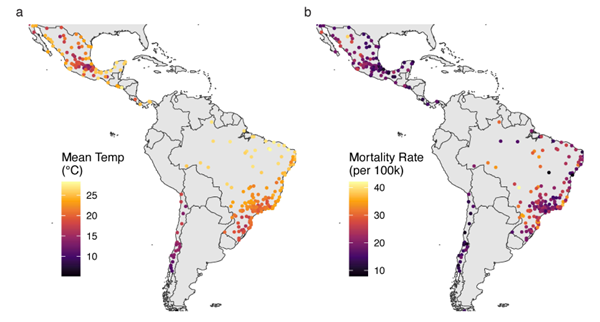Rising Temperatures, Rising Risks For Traffic Fatalities in Latin American Cities
PHILADELPHIA, PA,
October 6, 2025
Reading time: 5 min
Across Latin America, high temperatures are associated with an increase in traffic fatalities. A recent SALURBAL study examined temperature and traffic fatality data across 272 cities in six Latin American countries—Brazil, Mexico, Chile, El Salvador, Panama, and Costa Rica—between 2000 and 2019, and provides important insights regarding equity and vulnerability as cities throughout the region face a warming climate in the context of high urbanization and increasing motorization.
The authors found that traffic-related deaths increase as temperatures rise, with risks especially high on extremely hot days. Published in Nature Cities, the study was led by Cheng-Kai Hsu, a postdoctoral researcher at the Institute of Transportation Studies at the University of California, Berkeley, and a member of the Salud Urbana en América Latina (Urban Health in Latin America, or SALURBAL) Project. Co-authors included researchers from Drexel University, Mexico's National Institute of Public Health, the National University of Lanús in Argentina, the Federal University of Minas Gerais and the University of São Paulo in Brazil.
- Increased risks from high temperatures are especially pronounced for younger people (19 years and under), males, and users of motorcycles and bicycles.
- People in hotter cities, and in those with longer commutes and on longer streets, face greater risk. This risk is often even higher for lower-income residents, who more frequently rely on walking, cycling, or open-air transport that offers little protection from the heat.
- Heat-related traffic fatalities are expected to increase, especially in the region's warmer cities.
- These findings have implications for public policy that can target protection for vulnerable road users, especially residents of city outskirts who face long, heat-exposed commutes on informal transit and with limited alternatives.

Extended Data Fig. 1 Annual median temperature and road traffic mortality rate by city.
Globally, road-traffic injuries are responsible for an estimated 1.25 million deaths each year. According to the Pan American Health Organization (PAHO), road traffic injuries caused nearly 150,000 deaths in the Americas alone in 2010. While high temperatures are known to contribute to road traffic mortality and injuries, this study was the first to explore the impact of heat on the risk of road traffic deaths across multiple cities in Latin America.
Across the cities included in this study, the risk of a traffic-related death was 1.16 times higher on very hot days and 1.18 times higher on extremely hot days, compared to the risk on days with the ideal temperature for safe driving. Because the studied cities are highly heterogeneous, the researchers analyzed temperature on a relative scale. This method identified the "optimal temperature"—the point at which the risk of a road death is lowest for the group of cities as a whole.
The increase in risk was greatest for motorcyclists and bicyclists, in cities with generally hot climates, and where people face particularly long commutes. The researchers estimate that extreme heat was responsible for 0.74% of all road traffic deaths in the region between 2000 and 2019. For motorcyclists alone, that figure was even higher, at 1.17%.
As the first study to analyze the impact of temperature on traffic deaths across many cities in the region, this work provides strong evidence that high ambient temperature significantly increases the risk of traffic fatalities. The research also offers new insights into how this risk affects different groups of people, users of various transportation modes, and cities with unique climate and urban design characteristics. Unlike heat's effect on health, which often worsens existing conditions, heat is associated with traffic deaths, impacting otherwise healthy individuals.
 These risks are not distributed equally. Residents who rely on motorcycles, bicycles, or walking for transportation face much higher exposure to high temperatures.
These risks are not distributed equally. Residents who rely on motorcycles, bicycles, or walking for transportation face much higher exposure to high temperatures.
For example, gig-economy motorcyclists (Rappi, Uber Moto) are directly exposed to extreme heat while driving. These risks can compound, as demand for deliveries spikes during heatwaves, which is also linked to riskier driving behavior. These workers often have fewer alternatives and may not be able to change their travel schedule, switch modes, or decline work without a penalty, even on extremely hot days.
“Our results highlight the urgent need to study climate–transportation intersections in diverse, rapidly urbanising and motorising contexts,” says lead author Cheng-Kai Hsu, a postdoctoral scholar at UC Berkeley. “For policymakers, the findings underscore the importance of adapting road safety strategies and transport systems to protect vulnerable populations as cities get hotter.”
Why does this happen, and what can we do to address it?
The link between heat and road mortality might be explained by several factors: drivers can become distracted, fatigued, or have slower reaction times in the heat. Hot weather can also lead to more aggressive or impatient driving behaviors, such as speeding. These issues can compound the effects of other factors on hot days, such as increased traffic, a higher risk of vehicle malfunctions, softened road surfaces, and slower emergency response times.
“Cities must diligently adopt a safe system approach to road safety that is forgiving of human mistakes and individual behaviors. The safe system approach for road safety focuses on safer road design, safer vehicles, safer road users, and effective post-crash care,”says Carolina Pérez Ferrer, research scientist at the National Institute of Public Health of México and co-author of the study,“The need for such an approach is especially critical in light of these new findings showing that rising temperatures are linked to increased road mortality, making it all the more important to create environments that protect vulnerable road users in a warming climate.”
Proactive measures can reduce heat exposure among road users. Practical interventions such as installing shaded waiting areas and rest zones along high-traffic corridors and incentivizing ventilated or heat-reflective vehicle designs can offer immediate relief. Formalizing informal transport sectors, including motorcycle taxi services, also presents an opportunity to improve occupational safety standards and extend social protections. In addition, it will be necessary to adapt to rising temperatures by designing safer roads and safer vehicles that are forgiving of human mistakes and protect life. This includes infrastructure and regulation for safe speeds, use of personal safety devices, and strict enforcement of traffic laws. As the climate continues to warm, integrating heat mitigation and adaptation strategies into transport systems is essential to saving lives.
_____
This project was supported by the Wellcome Trust initiative Our Planet, Our Health (grant no. 205177/Z/16/Z). The authors also acknowledge partial support from NIH grant P20MD019221.
Contact: Carolina Rendón, Communications Specialist - cr3283@drexel.edu